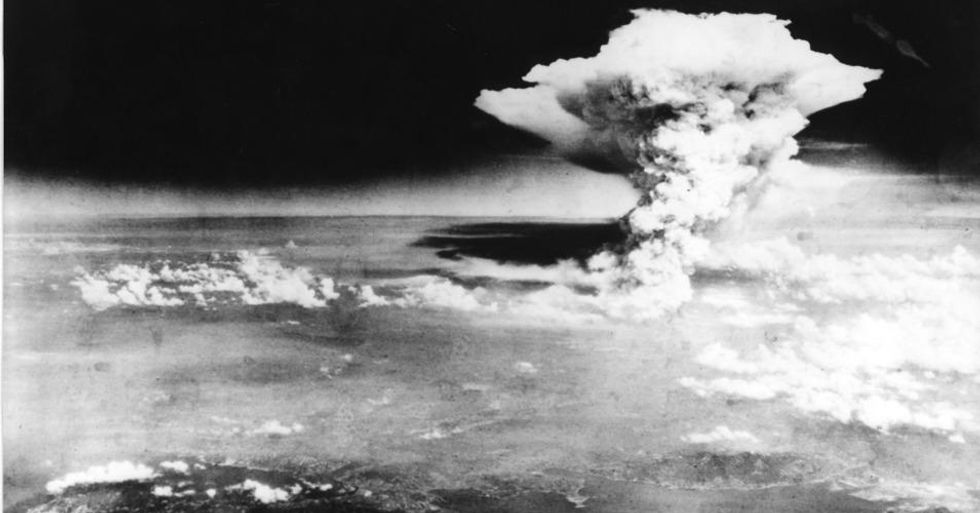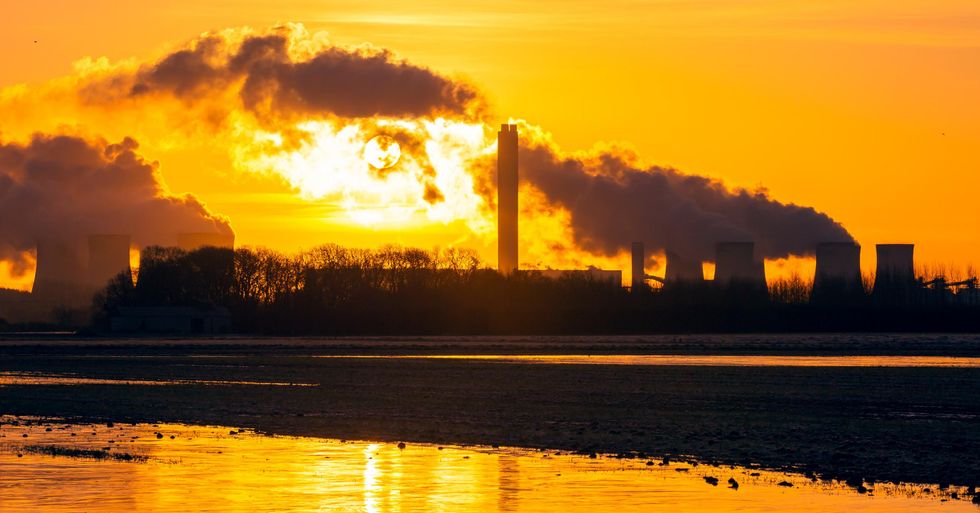Three Ways to the End-Time
Give humanity credit. Between nuclear war, the climate emergency, and potentially AI, no other species could possibly have discovered so many different ways to destroy itself and most other creatures on Planet Earth.
In case you hadn’t noticed—and how could you not?—there have been more than 500 (yes, 500-plus!) wildfires burning across the vast reaches of Canada, an unheard-of number, and more than half of them completely out of (human) control in a record-shattering fire season. That’s been true for seemingly endless weeks now with no end in sight. (And, by the way, elsewhere in the northern hemisphere, Siberia is having its own possibly record fire season.) If you didn’t notice any of this, though, I have a possible explanation. Perhaps the vast clouds of smoke from those fires that recently gave the skies of Chicago and Detroit, New York and Washington, D.C., the worst air quality on the planet blurred your vision.
Anyway, if you were to look back, say, a decade or two ago, I have no doubt you would be struck by how few commentators even faintly imagined the planet we’re living on at this very moment—and not, as predicted, 2033 or 2043 or 2053, if ever. Few imagined that the oceans would heat so quickly; that Texas and parts of the southern U.S. would be experiencing the sorts of fever-dream temperatures this summer that once might, at worst, have been associated with northern India; that Europe would, in recent years, have recorded heat and drought of a sort not seen in half a millennium; that China would break heat, fire, and flood records, while Antarctica’s sea ice hit record lows.
Last season, when fires fiercely scorched northern Canada, who would have predicted that this year far more acreage would burn nationwide long before the fire season was faintly near an end, sending yet more carbon into the atmosphere to make future seasons even worse? Oh, and just recently, the planet experienced its hottest day ever, in all of human history—or at least during the last 125,000 years. But count on one thing: It won’t be the hottest day ever for long. (Oh, wait! The very next day, July 4, proved in true patriotic fashion to be even hotter and the following day tied it for the record with, by the way, 57 million Americans under an extreme heat watch!) In the weeks to come, we may even pass the 1.5°C temperature limit set just eight years ago as part of the Paris climate agreement. And the saddest thing of all is that I could go on and on… and yes, on.
Early in this century, I certainly grasped something of the possible grim future reality of climate change, but I didn’t personally expect to live through it in any major way.
Hey, I don’t blame you if you’re shocked. Honestly, who knew? I didn’t, and I suspect I was typical. Early in this century, I certainly grasped something of the possible grim future reality of climate change, but I didn’t personally expect to live through it in any major way. Though I already imagined it as a potential nightmare for future life on this planet—even possibly the nightmare of all times—the emphasis was on that “future.” I imagined my children (or possibly, though they didn’t exist yet, my grandchildren) having to face such a potential horror, but not me, not in a major way in my own lifetime, and in that inability to truly grasp what was coming I was in the company of many climate scientists.
And yet I now find myself, like you, like all of us, experiencing the idea of future global warming being transformed before my very eyes into a climate emergency of the first order.
Nuking Planet Earth
 A photograph of the atomic bomb dropped on Hiroshima.
A photograph of the atomic bomb dropped on Hiroshima.(Photo: Hiroshima Peace Memorial Museum)
Still, despite all the climate surprises in store for me and my generation, there were certain things that we already knew. For instance, just to change the subject for a moment—and I think you’ll see why soon enough—who today doesn’t know that, in the midst of World War II, scientists working for the American government invented (and yes, that word works as well for what they did as for Edison and the telephone) atomic weaponry—that is, a way to destroy not just two Japanese cities to end World War II in the Pacific but, as it turned out, humanity itself, lock, stock, and barrel!
If you don’t believe me, just check out what a relatively moderate atomic war on this planet might mean in terms of what’s come to be known as “nuclear winter.” In the wake of such a conflict, it’s expected that billions of us would all too literally starve to death. (And as with climate change, count on one thing: The reality is likely to be worse than the predictions.)
Admittedly, from the beginning, the idea of such weaponry made at least a few of the scientists who created it, not to speak of the president of the United States, anxious. As President Harry Truman scrawled in his diary: “We have discovered the most terrible bomb in the history of the world. It may be the fire destruction prophesied in the Euphrates Valley Era, after Noah and his fabulous Ark.”
One of the leading atomic scientists, J. Robert Oppenheimer, later recalled the experience this way:
“We knew the world would not be the same. A few people laughed, a few people cried. Most people were silent. I remembered the line from the Hindu scripture, the Bhagavad Gita; Vishnu is trying to persuade the Prince that he should do his duty, and to impress him, takes on his multi-armed form and says, ‘Now I am become death, the destroyer of worlds.’ I suppose we all thought that, one way or another.”
Still, when two atomic bombs took out Hiroshima and Nagasaki, who could have imagined what the fallout of every sort from such weaponry, if enough of them were used in some future war, could potentially do to humanity (and much of the rest of life on this planet as well)? And once the Cold War ended with the collapse of the Soviet Union in 1991, who could have imagined that, in 2023, a Russian leader named Vladimir Putin, would rule over a country with more nuclear weapons than any other on the planet and would once again be threatening to use what are now called “tactical nuclear weapons” (even though many of them are far more powerful than the two that destroyed Hiroshima and Nagasaki) in—yes!—Europe (okay, officially, Ukraine) to save himself from the hellish war he launched?
Or for that matter, who in 1991 could have guessed that, more than three decades later, the U.S. and China would be locked in what has come to be known as a “new cold war” with the issue of the island of Taiwan at its heart and Americans gaining an ever more cold-war-style mentality? In that context, who would have guessed that, in 2023, China would be rushing to massively upgrade its nuclear arsenal, while, in the coming decades (if they were to come, of course), the U.S. was planning to invest another $2 trillion in the so-called modernization (a concept that doesn’t go very well with the potential ultimate destruction of Planet Earth) of its own vast arsenal. Or who could have guessed that, by 2023, nine countries would be nuclear-armed, including India and Pakistan (gulp!), Israel, and—yikes!—North Korea.
Admittedly, since August 9, 1945, though many nuclear weapons have been “tested,” most recently by the North Koreans, none have yet been used in war. Still, don’t faintly think it’s beyond the bounds of possibility, starting in Ukraine.
Another Kind of Fallout
 The sun rises behind cooling towers of a power plant in the English village Drax.(Photo: Coatesy/Getty Images)
The sun rises behind cooling towers of a power plant in the English village Drax.(Photo: Coatesy/Getty Images)But here’s the tricky thing. While some of the atomic scientists who helped create the first nuclear weapons quickly grasped that they would have the potential to destroy humanity, none of them imagined that humanity had already invented a means to do so all too “peacefully” by burning fossil fuels. None of them knew that putting carbon dioxide and other greenhouse gasses into the atmosphere might, in the end, fry the planet in something like slow motion rather than in an atomic instant. In other words, humanity had, however unknowingly as part of the industrial revolution, created another sort of “weaponry” that could again—not in a brief set of warring moments but over endless decades—do this planet in. That “bomb” couldn’t, in a sense, have been more peaceful.
Think of it this way: Humanity had—once knowingly and once without realizing it—created systems with the sort of devastating fallout that could, in the end, do us all in, and that represents a unique accomplishment of sorts. Of course, had more of us been paying attention, we would have realized this far sooner when it came to climate change. After all, in 1965, a science advisory committee provided President Lyndon Johnson with a report on the phenomenon that predicted what the carbonization of the atmosphere might do to this planet early in the next century with remarkable accuracy. So it wasn’t that we weren’t (or shouldn’t have been) warned. Johnson himself, of course, was so wrapped up in a disastrous war in Vietnam that he (and his advisers) seem to have paid no attention whatsoever.
The other crew who knew all too much about the heating of this planet early were the guys who, in the previous century, ran the giant fossil-fuel companies. From the 1970s on, Exxon’s scientists, for instance, kept that company’s executives all too up to date on the future fallout from the burning of the fossil fuels they were making their fortunes off of and those CEOs often responded—surprise! surprise!—remarkably decisively by ignoring the news, denying it, or even supporting organizations deeply involved in climate-denialism.
Ground Zeros
 Numerous experts and rights advocates are urging a pause on the development of artificial intelligence technology.(Photo: Monsitj/iStock via Getty Images).
Numerous experts and rights advocates are urging a pause on the development of artificial intelligence technology.(Photo: Monsitj/iStock via Getty Images).Give us—that is, humanity—credit. No other species could possibly have discovered two different ways to destroy itself, not to speak of most of the other creatures on Planet Earth. And in 2023, living in an ever more extreme country on an ever more extreme planet at a moment when both of those ways of ultimate devastation are once again distinctly in play, we shouldn’t underestimate who we are. In fact, the question of whether there is a third way is now up for grabs.
In other words, whatever you do, don’t sell us short! In the end (and I use that phrase advisedly), we may prove even more remarkable than we imagined and the fallout from the human brain almost beyond conception. In other words, don’t for a second think that humanity is restricted to just two versions of end-time. After all, as in 1945 with the atomic scientists, so today, some of the scientific figures who created artificial intelligence (AI) are beginning to warn us that it might ultimately (in every sense of the term) do us in.
Among them is the man known as “the godfather of AI,” Geoffrey Hinton, who quit his job at Google to express his fears about where we might indeed be heading, artificially speaking. “The idea that this stuff could actually get smarter than people,” he said, “a few people believed that, but most people thought it was way off. And I thought it was way off. I thought it was 30 to 50 years or even longer away. Obviously, I no longer think that.” Now, he fears not just killer robots beyond human control but “the risk of super intelligent AI taking over control from people… It’s a threat for the Chinese and for the Americans and for the Europeans, just like a global nuclear war was.”
Keep in mind, lest we underestimate humanity’s remarkably inventive powers yet again, that while AI might prove to be the third way we’ve created to potentially do ourselves in, even it might not be the last, not given who we are.
And keep in mind that we’re just in the earliest moments of AI’s development. Who knows, as Michael Klare recently warned us, what future global militaries run by “robot generals” with potential access to our nuclear arsenals could do to us.
The “fallout” from AI is still hard to begin to assess, even as militaries around the globe double their efforts to adapt it for uses of all sorts. And keep in mind, lest we underestimate humanity’s remarkably inventive powers yet again, that while AI might prove to be the third way we’ve created to potentially do ourselves in, even it might not be the last, not given who we are.
Whether another nuclear weapon is ever used or not (don’t do it Vlad!), in the heat of this record-breaking summer, this planet and everything on it are already suffering more and faster than just about anyone expected from one version of humanity’s fallout.
There was a phrase used with the atomic bombs that took out Hiroshima and Nagasaki and reused after September 11, 2001, for the site in New York where al-Qaeda hijackers took down the World Trade Center: “Ground Zero.” Increasingly, with the never-ending burning of fossil fuels, Ground Zero is no longer a single city of any sort, but this planet itself and, whether we’ve already found a third way to destroy ourselves (and so much else) or not, there is something awesomely ominous about our urge to destroy so much with our multiplying versions of fallout.

